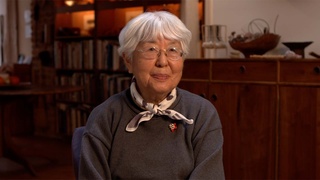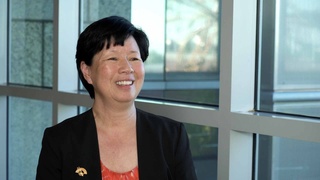Interviews
Impact of Pearl Harbor on her family
I can remember that term, Pearl Harbor, because I didn’t know what it was. I’m trying to put myself into that mind of a child of what was happening. A lot of it was confusing, a lot of confusion, wondered where my dad was. It was pretty harrowing when I think of it now because our family…we were a very tight family. Family was everything and my father was such the powerful center of it and then for him to just suddenly be taken away was very disconcerting and, you know, terrifying because he was a very strong and outspoken man. He could speak English very well. He spoke with a British accent because he studied in Japan where they spoke with a British accent. He was a very proud person so, you know, you felt safe with him and then suddenly he’s gone.
Date: December 27, 2005
Location: California, US
Interviewer: John Esaki
Contributed by: Watase Media Arts Center, Japanese American National Museum
Explore More Videos

Parents
(b. 1934) Award-winning Disney animation artist who was incarcerated at Topaz during WWII

The Dopey bank that survived the war
(b. 1934) Award-winning Disney animation artist who was incarcerated at Topaz during WWII

My daughter couldn’t fit in Japan, so I decided to go back to America (Japanese)
(b. 1936) Shin-issei welding business owner

Evacuated to the Jungle
(b. 1938) Philipines-born hikiagesha who later migrated to the United States.

Captured by Guerillas after bombing of Pearl Harbor
(b. 1938) Philipines-born hikiagesha who later migrated to the United States.

Grandfather picked up by US Army
(b. 1952) Former banking executive, born in Hawaii

Father's business partner operated their farming business during WWII
(b. 1935) Sansei businessman.

Father was convinced the constitution would protect him
(b. 1935) Sansei businessman.

The lack of discussion about family’s incarceration in Amache
Sansei judge for the Superior Court of Los Angeles County in California


Her brother’s reasons as a No-No Boy
(b. 1923) Japanese American poet, activist

Her grandfather was pressured to teach Japanese
Sansei judge on the Superior Court of Los Angeles County in California

Neighbor took care of her mother after grandfather was taken by FBI
Sansei judge on the Superior Court of Los Angeles County in California

Immediately after the bombing
(b. 1938) Japanese American. Hiroshima atomic bomb survivor

Other family members not as lucky
(b. 1938) Japanese American. Hiroshima atomic bomb survivor
